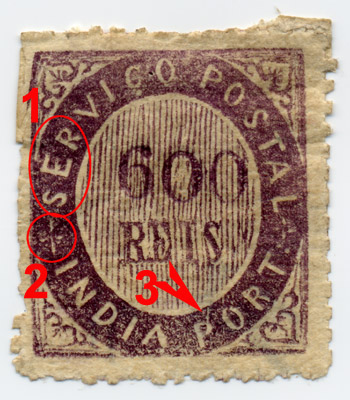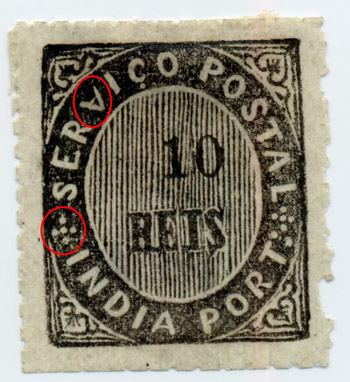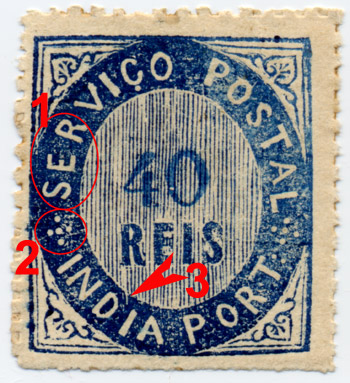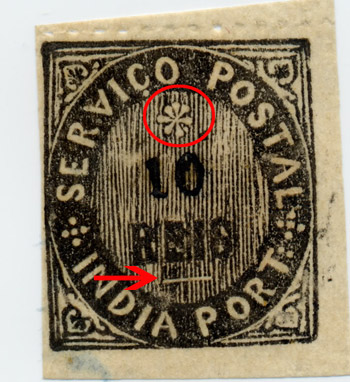The main types of the so-called "Native stamps" of Portuguese India are illustrated below.
Points to note in all issues are: the square, irregular, perforations that are so very characteristic; the particular shape of each letter and the shape of each word according to the Type; and the background pattern that must be studied and viewed as a fingerprint of the stamps.
A note: it is often said that the background lines are always very irregular in genuine stamps. It is usually, but not necessarily, so- some stamps, possibly printed when the dies were brand new, depict such a regular background that they look like forgeries although undoubtedly genuine.
Notice that the stamps are printed in several colors from the same dies; the values are individually printed in a second operation and their location thus varies from stamp to stamp.

The 600 Reis violet stamp at the left is a Type I stamp. Points to note are:
-the "SER" in "SERVIÇO", marked "1" at the image at left. Notice that the size of the "E" is larger than the size of the "S" or "R";
-the left and right ornaments in the shape of a cross made up from four small strokes (one of them is marked "2" in the image at left).
Other points to note are the 33 background vertical lines and the way they bend at the center to clear the letters in "REIS", and also the white line over the "P" (marked with arrow 3).
You can access a large image of Type I here.

Several variations of Type I exist, the most noteworthy of which is Type ID represented by the 10 Reis black stamp at left. Important differences are:
-the "V" in "SERVIÇO" is struck-through;
-the left and right ornaments are made of five dots as in Type II, below left.
Only the back 10 Reis and a red 20 Reis stamp were issued as Type ID.
You can access a large image of Type ID here.

The 40 Reis blue stamp at the left is a Type II stamp. Points to note are:
-the "SER" in "SERVIÇO", marked "1" in the image at left. Notice that the size of all letters is approximately the same;
-the left and right ornaments made up from five dots, as in Type ID (one is marked "2" at left) .
Other points to note are the 44 unbending background vertical lines; the white line between the "D" and the "I" of "INDIA" (marked with arrow 3).
You can access a large image of Type II here.

The 100 Reis green stamp at the left is a Type IIB stamp. The main difference from Type II is that the "V" in "SERVIÇO" is struck-through as in Type ID.
You can access a large image of Type IIB here.

The 10 Reis black stamp at the left is a Type III stamp. The main differences are the white star/blotch above the value and the lower white bar.
You can access a large image of Type III here.